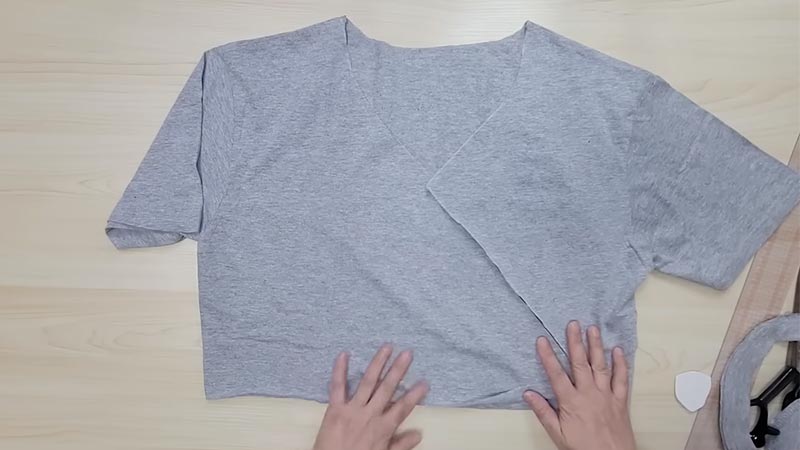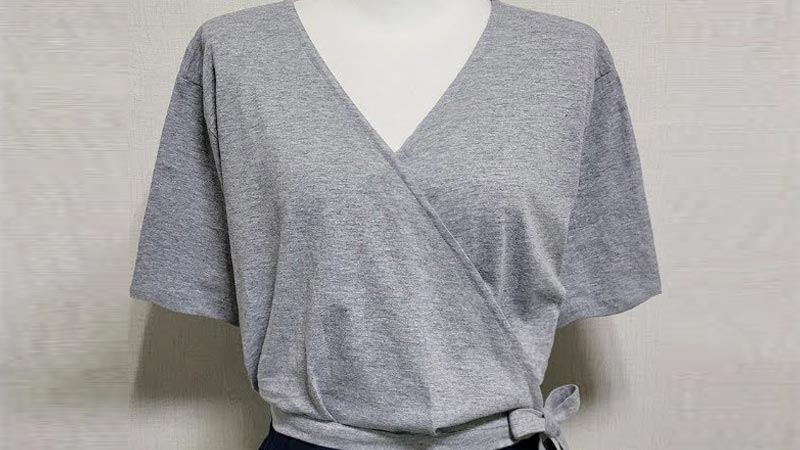Upcycling has emerged as a trend that’s both eco-friendly and fashion-forward in a world that’s increasingly conscious of sustainability.
Rather than discard old or worn-out garments, why not transform them into stylish, unique pieces that reflect your creativity?
Upcycling clothes reduces textile waste and allows you to personalize your wardrobe in ways that mass-produced fashion can’t match.
This guide explores many imaginative ideas for upcycling clothes, from turning vintage tees into trendy crop tops to repurposing denim jeans into chic handbags.
Whether you’re a seasoned DIY enthusiast or just starting, these projects are accessible and adaptable to various skill levels. Join us on this journey of reinvention, where old becomes new, and your closet becomes a canvas for your innovative flair.
Discover the joy of breathing new life into old fabrics and embracing a sustainable, one-of-a-kind fashion sense that’s uniquely yours.

Ideas for Upcycling Clothes
Upcycling clothes is environmentally friendly and an opportunity to showcase your creativity and style. Don’t be afraid to experiment with different materials, colors, and techniques to make each project uniquely yours. Here are some creative ideas for upcycling clothes in detail:
Denim Delights
Turn old jeans into stylish shorts or distressed denim skirts. Create a unique denim jacket by sewing on patches or adding fabric paint designs. Fashion a denim tote bag from the legs of jeans.
T-shirt Transformation
Crop oversized t-shirts to create trendy crop tops. Add fabric dye or bleach to create tie-dye or ombre effects. Convert old graphic tees into comfy pajama shorts.
Sweater Revamp
Transform an old sweater into a cozy cardigan by cutting it down the middle and adding buttons. Make cute mittens or leg warmers from the sleeves of sweaters. Combine different sweater scraps to create a patchwork scarf.
Button-Up Redesign
For a chic look, sew lace or embroidered fabric onto a plain button-up shirt. Turn an old button-up shirt into a trendy wrap top. Create a unique apron from an oversized men’s dress shirt.
Dress Renewal
Shorten a long dress to create a stylish midi or mini dress. Add fabric belts, sequins, or beadwork to breathe new life into an old dress. Convert a sundress into a breezy summer top.
Accessory Overhaul
Craft headbands from fabric scraps or old tights. Transform old scarves into infinity scarves or kimono-style tops. Create fabric-covered bangles and bracelets.
Revive Your Ripped Jeans
Patch up holes in jeans with colorful fabric, embroidery, or lace. Cut skinny jeans into trendy distressed shorts. Add leather or fabric patches for a unique biker-style look.
Embellished Jackets and Repurpose Socks
Bedazzle a plain jacket with rhinestones, studs, or sequins. Paint or bleach designs onto a denim or leather jacket. Sew on fabric patches or embroidery for a personalized touch.
Turn old socks into cozy arm warmers or leg cuffs. Transform colorful socks into playful fingerless gloves. Create sock puppets for a fun DIY project.
Shoe Makeover
Paint canvas sneakers with fabric paint to give them a fresh look. Add lace or fabric to flats or heels for a unique touch. Decorate old flip-flops with beads, ribbons, or fabric scraps.
Belted Beauty
Use old leather belts as stylish straps for a plain handbag. Create a fashionable cinch belt from a long scarf or fabric strip. Repurpose a wide belt into a chic headband.
Textile Wall Art
Frame fabric scraps in embroidery hoops for unique wall art. Create a fabric collage by sewing together various fabric swatches. Make fabric pennants or bunting for festive room decor.
Pillow Pizzazz
Craft decorative throw pillows by sewing together fabric remnants. Add fabric paint designs or embroidery to plain pillow covers. Transform an old sweater into a cozy pillowcase.
Backpack or Tote Bag Upgrade
Reinvent an old backpack by adding colorful fabric patches or embroidery. Create a tote bag from an old canvas or denim jacket. Sew fabric onto a plain tote bag to make it uniquely yours.
Personalized Patchwork
Combine fabric scraps into a patchwork quilt or blanket. Stitch together squares of old t-shirts to make a memory quilt. Craft a patchwork table runner or placemats for your home.
Sustainable Scrunchies
Sew fabric scraps into stylish scrunchies for your hair. Add decorative buttons or bows for extra flair. Create a matching set to coordinate with different outfits.
Kids’ Clothing Creations
Transform adult-sized t-shirts into adorable kids’ dresses or tops. Craft fun and colorful kids’ aprons from old shirts or fabric remnants. Make playful stuffed animals from fabric scraps for the little ones.
What Are the Benefits of Upcycling?

Upcycling is a sustainable practice that offers numerous benefits to both individuals and the environment.
This eco-conscious approach to reusing and transforming discarded items into something of higher value contributes positively to our lives in various ways. Below are some of the key benefits of upcycling:
Reduces Waste and Landfill Impact
Upcycling diverts textiles, clothing, and other items from ending up in landfills. The fashion industry, in particular, generates a significant amount of textile waste each year.
Upcycling old clothes and textiles can significantly reduce this waste, thus lessening the environmental impact.
Conserves Resources
Creating new items from scratch consumes valuable resources like water, energy, and raw materials. Upcycling requires fewer resources as it repurposes existing items. This conservation of resources is crucial in a world facing increasing resource scarcity.
Saves Money
Upcycling can be a budget-friendly way to refresh your wardrobe or home decor. Instead of buying entirely new items, you can transform what you already have at a fraction of the cost. This is especially valuable for individuals on a tight budget.
Promotes Creativity and DIY Skills
Upcycling encourages creativity and problem-solving. When repurposing old items, individuals often need to think outside the box, experiment with designs, and develop new skills. This fosters a sense of accomplishment and self-sufficiency.
Unique and Personalized Items
Upcycled items are inherently unique. They bear the individual mark of the creator, making them one-of-a-kind. You can personalize your upcycled pieces to reflect your style, making your wardrobe or home decor truly distinctive.
Reduces Carbon Footprint
The production and transportation of new goods contribute to greenhouse gas emissions. Upcycling, which often involves local and small-scale production, reduces the carbon footprint of manufacturing and shipping new items.
Preserves Cultural and Historical Value
Some upcycled items, especially vintage clothing and accessories, carry historical and cultural significance. By upcycling and preserving these items, we help safeguard our cultural heritage and fashion history.
Encourages Sustainability Consciousness
Engaging in upcycling encourages a sustainable mindset. It prompts individuals to think about the lifecycle of products, the environmental impact of their choices, and ways to reduce waste. This increased awareness can lead to more sustainable consumption habits.
Supports Local Economies
Many upcycling projects are small-scale and local, often involving local artisans and craftsmen. By supporting upcycled products, you contribute to the growth of local economies and sustainable businesses.
Builds a Sense of Community
Upcycling often involves collaboration and community engagement. Workshops, classes, and online communities centered around upcycling foster connections between individuals who share a passion for sustainability and creativity.
Extends the Lifespan of Items
Upcycling can breathe new life into items that may have otherwise been discarded due to minor flaws or wear and tear. This extends the useful lifespan of products, reducing the need for constant replacements.
Enhances Problem-Solving Skills
Upcycling projects often require creative problem-solving. Whether it’s figuring out how to repurpose an item or overcoming challenges during the transformation process, upcycling enhances critical thinking and adaptability.
Inspires Environmental Stewardship
Upcycling is an example of how individuals can take responsibility for their environmental impact. It inspires others to consider more sustainable choices and contributes to a culture of environmental stewardship.
FAQs
What is the difference between upcycling and recycling?
Upcycling involves taking an old or discarded item and creatively transforming it into something of higher value or quality. It usually maintains or increases the item’s functionality or aesthetic appeal. On the other hand, recycling breaks down materials from discarded items to create new products.
How can I start upcycling if I’m not crafty or creative?
You don’t need to be an experienced crafter to start upcycling. Begin with simple projects like turning old jeans into shorts or adding fabric patches to a plain jacket. There are many online tutorials and workshops that can guide you through the process.
Are there specific materials that are best for upcycling?
Upcycling is versatile, and you can work with various materials. Common items include old clothing, fabric scraps, denim, wooden pallets, and furniture. The best materials often depend on your project and personal preferences.
Where can I find inspiration for upcycling projects?
Inspiration for upcycling projects can be found everywhere. Consider browsing websites like Pinterest or Instagram, where people share their upcycling ideas and creations. You can also visit thrift stores, flea markets, or garage sales to find unique items that can be transformed.
Is upcycling only for clothing and fashion items?
No, upcycling can be applied to a wide range of items beyond clothing. While fashion upcycling is popular, you can upcycle furniture, home decor, accessories, and even electronic devices. The key is thinking creatively about repurposing and transforming items to give them new life and purpose.
Conclusion
Upcycling clothes is more than just a hobby; it’s a statement of individuality, creativity, and environmental responsibility. As we conclude our exploration of ideas for upcycling clothes, we hope you’ve been inspired to embark on your own journey of transformation.
By doing so, you contribute to reducing fashion’s impact on the environment and redefine your personal style in a world saturated with uniformity.
Remember, upcycling is not limited by rules or trends; it’s an open invitation to innovate and express yourself. Whether you’re restyling old garments, embellishing accessories, or experimenting with dye and paint, each project is a testament to your imagination.
So, gather your old clothes, raid your craft supplies, and let your creativity run wild. With each stitch, cut, and embellishment, you’ll contribute to a sustainable fashion future while crafting a wardrobe that tells your unique story.
Leave a Reply